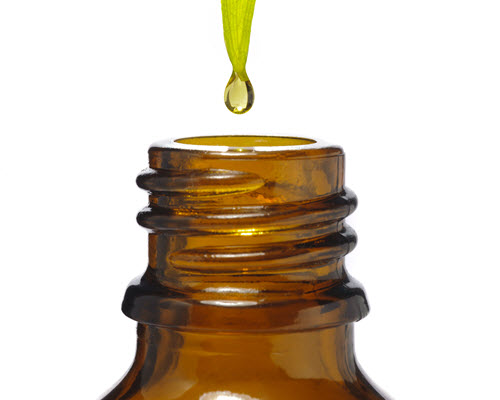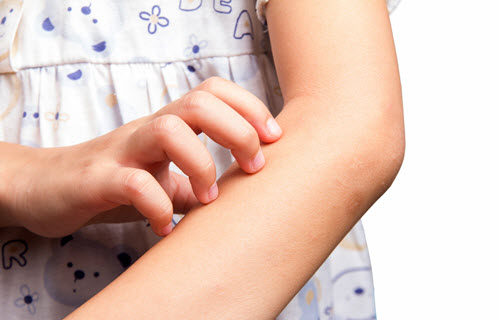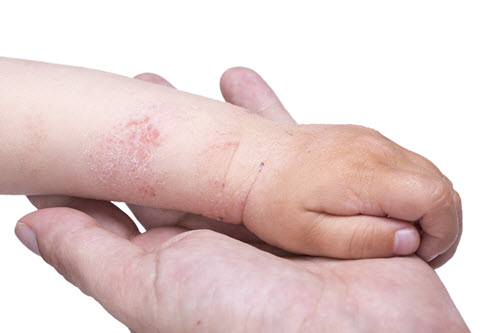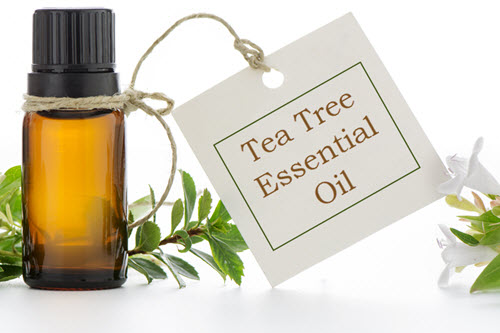7 Uses of Tea Tree Oil for Kids’ Skin Problems


Her eyes were swelling up in tears, and there I was looking at a tiny arm with a large, swollen red area. Sure enough, my daughter had been stung by a bee, and needless to say she wasn’t too happy about it.
I proceeded to do what I always do when something goes wrong – I applied ice, followed by some cortisone cream and hoped it would at least become manageable before bedtime.
Wrong. And I felt horrible.
We unfortunately struggled with the redness and swelling for several days until a friend suggested tea tree oil.
I’ll admit I was skeptical. I thought to myself, “What could THIS do for a bee sting?” as I held it in my hand and stared at the label…
I applied it just as she suggested, and within a few hours that tiny little arm was of normal color and we got some much needed rest that night.
I don’t like to use the words “miracle” or “cure,” but if there was ever a time when it might be applicable, it was that day.
Tea tree oil is one of the most powerful and well-studied essential oils on the market today, with over 300 scientific studies referring to its antimicrobial capabilities alone. Scientific research backs what we have known for a long time: tea tree oil is a powerful, natural tool for health.
A Rediscovered Ancient Wisdom
While pharmaceuticals have been around for about a 100 years, our ancestors relied on essential oils for first aid problems before that.
Aboriginal tribes in Australia have known of the tea tree’s healing qualities for thousands of years, primarily using it for it’s antiseptic properties and prized healing ability.
During World War II, Australian soldiers were issued this natural oil as one of the prime components in their first aid kits.
The commercial tea tree oil industry originated in the 1920s when Arthur Penfold, an Australian, reported that tea tree oil had promise as it exhibited powerful antiseptic properties. Upon disclosing his discovery, scientists began testing and conducting research on the oil’s properties.

The profound results made their way into medical and scientific journals of the day, concluding that tea tree oil was a near perfect antiseptic. Mechanization, established in the 1970’s, allowed for the large scale production of tea tree oil that we’ve come to know today.
What Is Tea Tree Oil?
Tea tree oil, also known as melaleuca oil, is a yellowish colored essential oil that is made from the leaves of the plant Melaleuca alternifolia (native to Australia). The oil is steam-distilled, which uses low pressure and temperature that ultimately results in an oil that is pure. This is how ancient cultures distilled oils for thousands of years, which proved to be important for potency and efficiency.
And the potent nature of tea tree oil makes for an extremely cost efficient product.
One bottle this tea tree oil, when applied with a carrier oil, provides 50 oz of solution, compared to popular topical creams which typically provide 1 oz of solution for the same price.
Tea Tree Oil Is Safe and Easy to Use
Applying tea tree oil with a carrier oil provides a safe and effective way to use the product. Fractionated coconut oil is an all-natural carrier oil that readily absorbs into the skin, making it ideal for topical therapies. It is completely soluble with all essential oils and is colorless, odorless, and will not stain or go rancid.
While regular coconut oil can also be used, it is not quite as convenient. Regular coconut oil is solid at room temperature, making it hard for mixing and leaves a greasy feeling on the skin.
Fractionated coconut oil serves 3 purposes:
- Provides a medium that helps increase absorption of the tea tree oil into the skin.
- Helps spread the oil over a larger surface of the skin
- Lowers the chance of skin irritation
Basic Tea Tree Solution Recipe: A 1% dilution is recommended for children 6 years and older.
To prepare this dilution, add 1 drop of tea tree oil per teaspoon of carrier oil. You can do it at home or you can buy pre-made solutions.
Variations of this basic solution enable treatment of several of today’s common skin issues. As a mom with small children, I’ve found tea tree oil solutions to be one of my best friends.
Any Mom’s 7 Favorite Uses for Tea Tree Oil
Personally, I don’t want to expose my kids to pharmaceuticals and toxins if possible, so I’ve tested tea tree oil in many ways. The following are my favorite seven…
1.) Disinfectant/Hand Sanitizer
This recipe is perfect for those times when washing with soap and water isn’t an option. I like to carry a bottle in my diaper bag, purse, and gym bag. I even shared it with my child’s teacher to utilize at school.
Ingredients:
- 25-30 drops of tea tree oil
- 9 drops of lavender oil
- 9 drops of clove oil
- 1 tablespoon of witch hazel (optional)
- 16 tablespoons (8 ounces) aloe vera gel
Directions:
Combine 9 drops of both lavender and clove oil, along with 25-30 drops of tea tree oil. Stir together and add 16 tablespoons (8 ounces) of aloe vera gel along with 1 tablespoon of witch hazel (if you’re going to use it).
Blend together, add to container (old hand sanitizer bottles work well) and store out of direct sunlight in a cool place for up to 1 month.
Tip: Does not have indefinite shelf life due to the lack of concentrated alcohol content store-bought hand sanitizers have.
2.) Cuts/Scrapes
A cut can be painful, but not compared to that of an infected one. Tea tree oil has been used for centuries to heal cuts and scrapes.
Directions:
Prepare a 1% dilution by adding 1 drop of tea tree oil per teaspoon of carrier oil.
Clean the area first with water and apply solution every 2-3 hours. Be sure to cover the perimeter of the wound to help combat a possible infection. A bandage should also be applied if your child is headed outside to play or going to be coming into contact with soil.
Tip: For deeper cuts and scrapes, please use your judgement and consult medical attention if necessary.
3.) Insect Bites

Have you ever been on a hike with your kids and forgot bug spray? It’s happened to me and I was left with 2 cranky, itchy children. Thankfully, tea tree helps to relieve the redness, swelling, and irritation bug bites leave behind.
Directions:
Prepare a 1% dilution, by adding 1 drop of tea tree oil per teaspoon of carrier oil and apply to cleansed, affected area every 2-3 hours as needed.
Tip: Insects hate tea tree oil, so I love to use this as a natural bug repellant as well.
4.) Sunburn
Kids and sunburns don’t mix, yet it can be easy to forget that one little spot on your child’s arm. Here’s how to relieve the burning, itching, redness and peeling that can accompany sunburn:
Ingredients:
- One part tea tree oil
- 8 parts coconut oil
- 8 parts aloe vera- (juice from the plant is best)
Tip: Aloe Vera acts at the epithelial level of the skin to help protect and replenish its moisture. If you have access to an aloe vera plant, here’s a quick one minute video on how to extract the juice.
Directions:
Mix all ingredients and apply solution to affected area at least 2 times per day and after each shower/pool session.
5.) Acne (teenage children)
Choosing a product to treat acne can be extremely overwhelming, but tea tree oil is proven to be effective.
“Because tea tree is a natural antibacterial and antiseptic, I have had great success using it topically for skin conditions like acne and dermatitis.” –Dr. Tanda Cook, ND
Directions:
Add 1-2 drops of tea tree oil to a damp cotton ball and apply to the affected area once per night before bed. Leave for a few minutes and rinse with water.
Tip: Skin may be sensitive to direct sunlight after use. Use caution as necessary. Use with Manuka honey for an amazing skin care regimen.
6.) Eczema

The prevalence of childhood eczema in the U. S. and across other countries is on the rise. While tea tree oil is not a cure, its antibacterial, anti-fungal, and antiseptic qualities are scientifically proven to be outstanding in relieving the symptoms.
Directions:
Prepare a 1% dilution by adding 1 drop of tea tree oil per teaspoon of carrier oil and apply to cleansed, affected area 2-3 times per day. (Triple the recipe for larger areas.)
Increase the amount of carrier oil used if your child has sensitive skin or typically reacts to new substances.
Tip: Learn more about the root cause of eczema and why it may be occurring in your child.
7.) Diaper Rash
“I use tea tree oil on a regular basis for my patients. It is the most common oil I use and the first recommendation I make for parents to use on their children, especially for diaper and skin rashes.” ~ Ali Schweitzer, D.C.
The combination of tea tree oil and coconut oil works particularly well for yeast diaper rashes. This type of rash is characterized by well-defined borders, extreme redness, and lesions a slight distance from the main rash. It can be hard to get rid of and regular ointments didn’t cut it for me.
Directions:
Mix 5 drops of tea tree oil with 2 tablespoons of coconut oil and apply to affected area after each diaper change.
Tip: Increase the amount of coconut oil (carrier oil), if your child has sensitive skin.
The Drawbacks…
Undiluted tea tree oil may cause skin irritation (redness, itching, rash) in a small fraction of people. Using a carrier oil to dilute the solution can help minimize these reactions, by reducing the amount that penetrates the epidermis (outer layer of the skin).
This PDF report, produced by the Australian government, does a great job explaining the details around skin irritation, sensitization, and penetration when using tea tree oil.
Like most products, there are several cautions and warnings to be aware of:
- Children should NOT ingest
- Test on a small part of the body, prior to application
- Consult your healthcare provider for babies younger than 6 months (or if you have any questions or concerns)
- Keep away from open access to kids and babies
- Do not apply near the eyes or nasal passages and use caution when applying to deep/more serious wounds that need medical attention
Why I Choose Rocky Mountain Oils

If you’ve ever conducted any type of Google search on essential oils, you’ll find an overwhelming amount of information. There are a tons of options available, from inexpensive ones at your local grocery story to expensive ones sold exclusively through private distributors.
I chose Rocky Mountain Oils based upon 3 variables, including quality, affordability, and the company’s customer service.
1.) The fact that this direct-to-consumer company details the entire process of sourcing, sampling, testing, and analyzing the oils speaks volumes.
The oils are 100% Guaranteed Satisfaction of Quality (100GSOQ), and upon request the company will provide customers with GC/MS (Gas Chromotography – mass spectrometry) test results from a verified third-party, independent lab.
(To view the actual GC/MS test for your oil, simply enter the unique batch number found on the bottom of your bottle on this page, and click submit.)
2.) A 15mL bottle of Rocky Mountain Tea Tree Oil costs less than other major brands. Not to mention, all domestic orders ship for free.
3.) I have high standards for customer service (it’s what I do for my day job), so the option to chat with a live person in addition to the 90-day money back guarantee refund policy makes me a happy customer.
The customer reviews for tea tree oil speak for themselves…over 80 reviews with a 5-star rating.
If you’re skeptical, like I was, I can see why. When it comes to the health of our children, we’re often overwhelmed with information that can lead to frustration and uncertainty.
After a bit of frustration myself, I’ve put this oil to the test… and there is one thing I’m sure of: it works!
I suggest you try it – you won’t be disappointed.
The smile I get when applying this chemical-free oil on my children’s skin (and knowing it’s going to work) is priceless. You no longer have to feel guilty for using products with ingredients you can’t pronounce.
From one mom to another, I want you to smile too:)
-Lori Jo
Did You Like this Article?
Subscribe to our newsletter to receive email notifications, some ways to find relief, and next steps.
